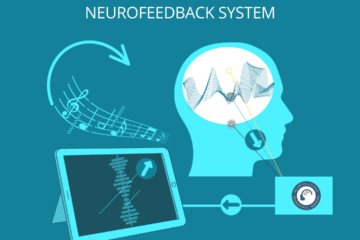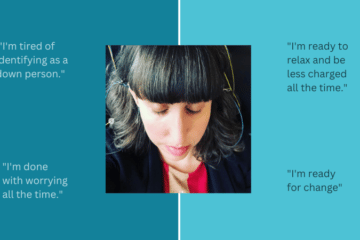When I first started meditating, I would sit down and be overcome by a waterfall of thoughts. Thoughts about my clients’ lives. Thoughts about what to do tomorrow. Thoughts about what to eat. Thoughts about the person sitting in front of me. Thoughts about the practice and whether or not I was doing it right.
Thoughts about myself, especially those that were doubt-ridden and questioned my basic worth. Like a continual movie playing out, sometimes stuck on the same tape-loop, regurgitating on itself; it often felt like acid reflux of the mind.
I would sit down and say “I want to be more available to others and this is why I’m doing this.” And inevitably, the same or a similar splice of the tape loop would re-appear, almost mocking my abilities to ever be able to accomplish this fully. How in the world can I be more available to other people when I can’t even be available to myself? And so the path began…
These thoughts often led to some kind of feeling tone on the cushion. Sometimes it was sheer panic and I wanted to stand up and walk out of the room as fast as possible.
Other times it was tight, narrow anger as I would be reviewing an uncomfortable conversation earlier with a co-worker. Sometimes it was a leaning towards something like my next meal or an attractive person in the room, which comically would lead to my whole torso, neck and head learning forward.
Sometimes I was purely numb and felt like an iceberg drifting in the Arctic. What was particularly interesting is that these feelings didn’t even need their normal labels: anger, passion, fear, ignorance. Sitting, it was possible to just observe their quality. Was it a colour? Somewhere in the body? Was it trying to say something?
A couple of years ago, I went to a week-long retreat in upstate New York. I had sprained my ankle severely shortly before the retreat, spending most of the time sitting in a chair and doing walking meditation with a brace.
Both teachers urged me to listen to myself whenever I needed to break by laying in the lounge. In that sense, even though I felt I was “missing out”, I began to learn what self-care meant on a fundamental level. Lying on the couch began to teach me that I needed to be my own friend. No one else was going to lie me down on the couch!
The same rings true for emotion; no one is going to soothe you like you will be able to and you have exactly what you need to do this at any moment. Just listen.
In the final interview I had with one of the teachers, I shared with her my fears of not being a “good enough” therapist. Very softly, she told me a story of one time when she was having a panic attack on her bed. Her friend, a somewhat stoic woman, sat by the bed and read the newspaper.
The panic attack let up. She relayed the feeling that this was the best way she could have been helped; by someone simply bearing witness. Upon returning home to the city, a close friend and teacher asked me what had I learned while on retreat.
I said, “so much… but most of all, that I can sit through anything, for myself and for other people.”
As a hormonal teenager, my emotional life felt like one big roller coaster. My mother would say, “Heather, feelings aren’t facts.” I love my mother, but perhaps this was a little too confusing for an already confused, Nirvana head-banging, sulky, shoulders-rolled-forward teen. Mom, that’s a partial truth. On one hand, these crazy things called emotions are valid. They are happening, aren’t they?
Something is happening. However, most of the time, we are responding to this present moment, such as that particular person’s “look they give you”, with information from our past. We map on to our experience and tend to generalize all “looks” with past looks we’ve received. Your particular version of that look is partially true and partially a projection.
Your response to this event, emotional or otherwise, is very different than perhaps how your friend would respond. Perhaps they wouldn’t even care or they could get completely bent out of shape. Regardless, it points to just how unsolid and unstable our thoughts and emotions are when it comes to any given situation; albeit completely valid, they are half-truths.
So there are two distinct ways that we can work with emotions. The first is to deconstruct them. Where is this coming from? What is its quality, colour, place in the body? Is it even mine? What’s accurate or inaccurate about it? Sakyong Mipham Rinpoche relates, “dismantling is grounded in knowing that no matter how solid the emotion feels, it’s fabricated. Everything in the world is made of parts and emotion is no different. The most painful, powerful part of negative emotions is that they seem complete and whole.”
For instance when faced with fear, oftentimes we are confronted with parts of our life that we consider to be “snake-like” or a threat. But is it accurately a snake or a threat? Sometimes yes, sometimes no.
When we turn on the light by paying attention to it, we may see that it was just a rope. Recently, I also heard an example of seeing a T-Rex composed of legos. When you break the seemingly threatening T-Rex into its constituent lego parts, he doesn’t seem so scary anymore.
The second way, my personal favourite, is to bear witness to it and to “learn to stay.” When we are panicking, it can seem as though that is all there is. The room “narrows” and we begin to have bodily sensations as though all the fire alarms are going off at once.
This can happen on and off the cushion, with or without a “threat” right in front of us. What if we started to pay attention to it? What if we held our ground, our seats and became curious about it? We may begin to notice that it is not that solid. It also doesn’t have a location. Not only that, it may start to become very small. So small that the rest of the room, the people in it, the walls, the sky, the floor, the sounds, the breath, the smells, the infinite space, can begin to bear witness with you. It begins to gently hold that emotion with you.
Some people don’t know what they are feeling at all. This modern life has disconnected us from our bodies. Or perhaps we were taught that we shouldn’t feel certain things and so we learned to close off the valve. Essentially, we closed off from the neck down.
So if that’s the case, we need to start getting in better touch with what is happening internally in the body. The body is a storehouse for emotion and past experiences. If this is the case, can we gently start to bring our attention to what’s happening in there?
You may be surprised how much it has been trying to communicate to you. Stop. Slow down. Look inward with respectful curiosity.
When I was about six years old, my father held me on the terrace at our first apartment in Chelsea. He held me underneath the stars, wrapped tightly in a soft cotton comforter, like a squirmy burrito. I felt utterly safe in that simple moment.
Oftentimes, when I am sitting with difficult emotions, I am reminded of how my father held me like a burrito. My father is now 75 and I’m in my 30s, so this probably can’t happen again. Perhaps we all need to learn to hold ourselves because there might not be anyone around to do it for us.
We can feel lonely on this path, in this life. It’s true. You are alone in your experience. No one can ever fully understand that but you. What would it be like to be your own best friend? What would it be like to remember that this space, this world, will always bear witness to what you’re feeling?
You may also be surprised that the more you pay attention to yourself, the more you will naturally have empathy and be able to understand others clearly.


